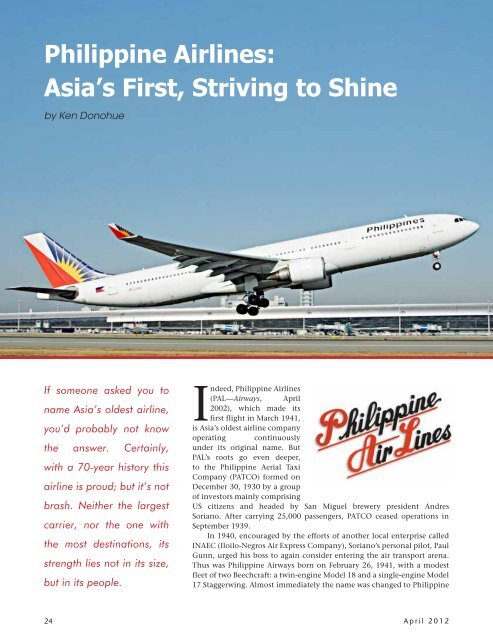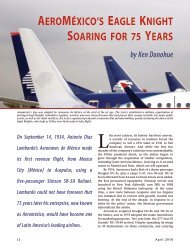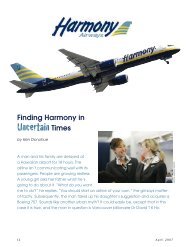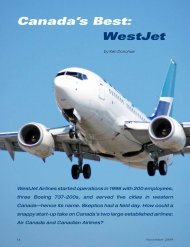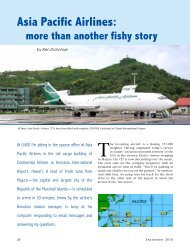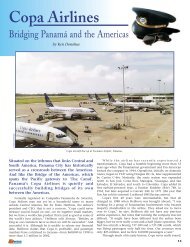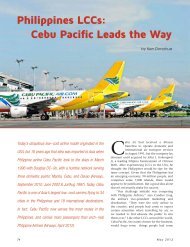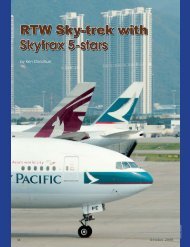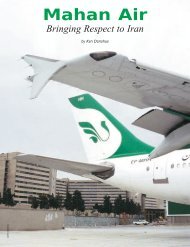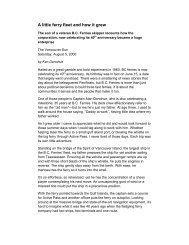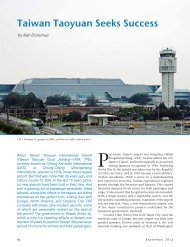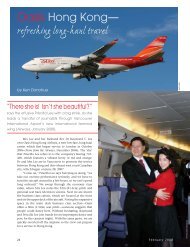Philippine Airlines: Asia's First, Striving to Shine - Ken Donohue
Philippine Airlines: Asia's First, Striving to Shine - Ken Donohue
Philippine Airlines: Asia's First, Striving to Shine - Ken Donohue
You also want an ePaper? Increase the reach of your titles
YUMPU automatically turns print PDFs into web optimized ePapers that Google loves.
<strong>Philippine</strong> <strong>Airlines</strong>:<br />
Asia’s <strong>First</strong>, <strong>Striving</strong> <strong>to</strong> <strong>Shine</strong><br />
by <strong>Ken</strong> <strong>Donohue</strong><br />
If someone asked you <strong>to</strong><br />
name Asia’s oldest airline,<br />
you’d probably not know<br />
the answer. Certainly,<br />
with a 70-year his<strong>to</strong>ry this<br />
airline is proud; but it’s not<br />
brash. Neither the largest<br />
carrier, nor the one with<br />
the most destinations, its<br />
strength lies not in its size,<br />
but in its people.<br />
Indeed, <strong>Philippine</strong> <strong>Airlines</strong><br />
(PAL—Airways, April<br />
2002), which made its<br />
first flight in March 1941,<br />
is Asia’s oldest airline company<br />
operating continuously<br />
under its original name. But<br />
PAL’s roots go even deeper,<br />
<strong>to</strong> the <strong>Philippine</strong> Aerial Taxi<br />
Company (PATCO) formed on<br />
December 30, 1930 by a group<br />
of inves<strong>to</strong>rs mainly comprising<br />
US citizens and headed by San Miguel brewery president Andres<br />
Soriano. After carrying 25,000 passengers, PATCO ceased operations in<br />
September 1939.<br />
In 1940, encouraged by the efforts of another local enterprise called<br />
INAEC (Iloilo-Negros Air Express Company), Soriano’s personal pilot, Paul<br />
Gunn, urged his boss <strong>to</strong> again consider entering the air transport arena.<br />
Thus was <strong>Philippine</strong> Airways born on February 26, 1941, with a modest<br />
fleet of two Beechcraft: a twin-engine Model 18 and a single-engine Model<br />
17 Staggerwing. Almost immediately the name was changed <strong>to</strong> <strong>Philippine</strong><br />
24<br />
A p r i l 2 0 1 2
BILL LARKINS/JW COLLECTION<br />
Air Lines, and PAL’s first flight was operated on March 15, from its home base at Manila<br />
<strong>to</strong> Baguio, a resort in northern Luzon, with Gunn at the controls of the Beech 18. Two<br />
days later the Staggerwing began service <strong>to</strong> Legaspi, and the network was extended even<br />
farther, <strong>to</strong> Daet, Naga, Masbate, Tacloban, and Cebu, with the introduction of a second<br />
Beech 18 in April.<br />
Ironically, INAEC—the inspiration behind PAL’s creation—ceased <strong>to</strong> exist when its<br />
entire fleet was destroyed by a Japanese aerial attack on Iloilo on December 18, 1941.<br />
But the carrier re-emerged after the war as Far Eastern Air Transport Inc (FEATI), which,<br />
with another privately owned company, Commercial Air Lines Inc (CALI), was absorbed<br />
by PAL, in 1947 and 1948, respectively.<br />
At the time of PAL’s inauguration, the company used Nielson Airport, named after<br />
New Zealander Laurie Reuben Nielson, who, in the Thirties led the establishment of the<br />
airport and an aviation school in Manila’s Makati area, now home <strong>to</strong> the city’s thriving<br />
business district. In fact, the former airport’s runways, 07/25 and 12/30, are now two<br />
major streets: Paseo de Roxas and Ayala Avenue, respectively.<br />
With the outbreak of war in the Pacific in December 1941, Gunn used his so-called<br />
‘Bamboo Fleet’ <strong>to</strong> support General Douglas MacArthur’s operations until the aircraft<br />
were destroyed and Nielson Field badly damaged. (Nielson himself was captured by<br />
JW COLLECTION<br />
Thanks <strong>to</strong> support from<br />
KLM Royal Dutch <strong>Airlines</strong>,<br />
PAL introduced DC-8 service<br />
in 1962.<br />
PAL DC-6 ‘Sleeper Plane’ (PI-C293) at San Francisco.<br />
JACQUES GUILLEM COLLECTION<br />
PAL briefly operated the eight-passenger Scottish Aviation Twin<br />
Pioneer (with Pratt & Whitney R-1340 engines instead of the<br />
original Alvis Leonides) on its Rural Air Service.<br />
the Japanese and interned in Hong Kong, where he<br />
disappeared without trace; both Soriano and Gunn<br />
reached Australia.)<br />
After the end of hostilities, with the help of<br />
Transcontinental & Western Air (TWA), PAL resumed<br />
service in 1946, serving 15 domestic destinations with<br />
Douglas DC-3s. The same year, PAL became the first<br />
Asian airline <strong>to</strong> cross the Pacific when it chartered a<br />
DC-4 from Transocean Air Lines <strong>to</strong> transport US military<br />
personnel from Manila <strong>to</strong> Oakland, California. This<br />
paved the way for PAL <strong>to</strong> inaugurate regular service <strong>to</strong><br />
San Francisco by year-end.<br />
In 1947, the fledgling airline expanded its wings<br />
A i r w a y s<br />
25
In-flight with <strong>Philippine</strong> <strong>Airlines</strong><br />
Flights: PR107 & PR106<br />
Route: Vancouver, British Columbia (IATA: YVR)–Manila (MNL)–YVR<br />
Aircraft: Airbus A340-600<br />
<strong>to</strong> Europe, and a year later operations were moved<br />
from Nielson <strong>to</strong> Nichols Field in Pasay City, when the<br />
government turned this former US Army Air Forces<br />
(USAAF) base in<strong>to</strong> a new airport for Manila. It is still<br />
home <strong>to</strong> the country’s main gateway, Ninoy Aquino<br />
International Airport (MNL), located only 4mi/6.5km<br />
from down<strong>to</strong>wn.<br />
Like the <strong>Philippine</strong>s itself, the national airline<br />
has experienced its share of tribulations, including<br />
terrorism and corruption, which left PAL financially<br />
vulnerable and unstable, and in 1973 President<br />
Ferdinand Marcos instituted a one-airline policy,<br />
closing down competi<strong>to</strong>rs Air Manila and Filipinas<br />
Orient Airways. After 15 years the monopolistic rule<br />
of <strong>Philippine</strong> skies came <strong>to</strong> an end in 1988 when<br />
President Corazon Aquino revoked the nation’s<br />
restrictive air carrier policy, and four years later the<br />
government sold the flag carrier.<br />
That <strong>Philippine</strong> <strong>Airlines</strong> is still flying after more<br />
than seven decades is a testament <strong>to</strong> the character<br />
of its people. Like Manny Pacquiao, the <strong>Philippine</strong><br />
boxing sensation, PAL is a scrapper; each time the<br />
airline is ‘knocked down’, it gets back up stronger<br />
than before.<br />
PAL’s most recent bout came in 1998, when<br />
after only six years after privatization a pilot and<br />
times a week <strong>to</strong> Vancouver from Manila. During<br />
annual peak periods daily flights are offered. Four<br />
days a week, the airline operates a service between<br />
Vancouver and Las Vegas, with fifth freedom rights over<br />
the route.<br />
Check-in was quick and efficient, and while ultimately<br />
unsuccessful, the agent made a valiant attempt <strong>to</strong> find me<br />
a window seat.<br />
YVR, which in 2011 marked its 80 th year of operations, has<br />
received a number of international accolades in recent years,<br />
and in 2010 was rated by Skytrax as the best airport in North<br />
America. Apart from departures <strong>to</strong> New York, Taipei, London,<br />
and Sydney, the international gates were relatively quiet<br />
during this late evening period. Boarding began at 2255, our<br />
scheduled departure time, with no explanation for the delay,<br />
but the process was efficient, and the near-full aircraft was<br />
pushed out at 2310, only 15 minutes behind schedule. PAL<br />
operates the A340 in a two-class layout, with 44 seats in the<br />
Mabuhay (business) cabin, and 220 in Fiesta (economy) class.<br />
The cabin crew, attired in stylish tan-colored uniforms,<br />
warmly welcomed passengers and offered <strong>Philippine</strong><br />
newspapers and a modest overnight amenity kit. A humorous<br />
yet professional safety video was shown, which clearly had<br />
the desired impact as I noticed that people actually paid<br />
attention. One disappointment was that the airline’s A340s<br />
lack seatback personal televisions in economy. Movies were<br />
played on a small moni<strong>to</strong>r in the center of the cabin, and a<br />
screen at the front, which didn’t always work properly.<br />
International gates at YVR are on the opposite side of<br />
the airport from Runway 08R, used mostly for departures,<br />
so it <strong>to</strong>ok 20 minutes <strong>to</strong> taxi <strong>to</strong> the threshold. At 2330, the<br />
A340 lumbered in<strong>to</strong> the sky for the 6,500mi (10,450km)-<br />
long journey.<br />
Forty-five minutes after takeoff, dinner service began.<br />
I chose the beef dish, which was presented in a plastic<br />
JW COLLECTIONFor much of the year <strong>Philippine</strong> <strong>Airlines</strong> operates five<br />
26<br />
A p r i l 2 0 1 2
PHOTOS: KEN DONOHUE<br />
Mediocre meals, courteous crewmembers.<br />
box. While I may have been unlucky, it was one of the<br />
poorest meals I have experienced on a flight. The food was<br />
overcooked, leaving the rice and vegetables dry and hard,<br />
although the fresh banana was a pleasant surprise.<br />
Our route <strong>to</strong>ok us north along the west coast of<br />
Canada, over Alaska’s Aleutian Islands, then south over<br />
Russia’s Kamchatka Peninsula. We flew abeam Tokyo and the<br />
Japanese Islands, before crossing the <strong>Philippine</strong> Sea.<br />
Halfway in<strong>to</strong> the flight a snack was offered, and two<br />
hours before landing a hot <strong>to</strong>wel service preceded breakfast.<br />
PAL serves <strong>Philippine</strong> cuisine, so breakfast was similar <strong>to</strong> the<br />
dinner menu of rice with chicken or beef. This time I chose<br />
the former, which was much better than the first meal. The<br />
only other complaint was that as the flight wore on, the<br />
<strong>to</strong>ilets became a little untidy, <strong>to</strong> put it mildly.<br />
At 0425 local time, and 14 hours after leaving<br />
Vancouver, we <strong>to</strong>uched down on Runway 06 at MNL. A short<br />
taxi brought us <strong>to</strong> Terminal 2. Cus<strong>to</strong>ms and immigration<br />
formalities were very efficient, and within 20 minutes of<br />
landing I had exited the terminal. Because I didn’t have any<br />
checked baggage, I don’t know how long passengers would<br />
have been waiting for their luggage, but the baggage claim<br />
area is small, crowded, and inadequate, especially when<br />
large aircraft disgorge hundreds of passengers.<br />
no airline branding at the counters, only the name of the<br />
destination and flight number. A PHP750 ($17) departure fee<br />
is payable before proceeding through security. Airside, there<br />
are few shops and services <strong>to</strong> distract the traveller. At the<br />
boarding gate, passengers had <strong>to</strong> endure another security<br />
screening because this flight continued <strong>to</strong> the United States<br />
(Las Vegas).<br />
Our aircraft pushed back at 1700, five minutes after<br />
scheduled departure time, and with a late afternoon<br />
rains<strong>to</strong>rm lashing the Airbus, we taxied <strong>to</strong> the end of Runway<br />
24. Once airborne, we headed west over Manila Bay, then<br />
made a right turn tracking north over Luzon, the largest<br />
island in the <strong>Philippine</strong>s.<br />
Unlike the inbound flight, no newspapers were offered,<br />
though I leafed through the airline’s in-flight magazine<br />
Mabuhay. Not long after takeoff, drinks and dinner service<br />
was initiated. The beef and vegetables were delicious, despite<br />
being presented in a plain white cardboard box. Cabin<br />
attendants came by several times offering water. Before<br />
arrival, I chose the chicken adobo, a popular <strong>Philippine</strong> dish;<br />
it proved excellent, with a pleasing mixture of spices.<br />
At 1230 local time, we landed on Runway 08L, and by<br />
1237 were at the gate, almost 30 minutes early.<br />
Overall impression<br />
<strong>Philippine</strong> <strong>Airlines</strong> provided good service throughout.<br />
Cabin crewmembers were friendly and attentive, and<br />
announcements from the flightdeck before departure and<br />
en route were welcome. Unfortunately, the first meal en<br />
route <strong>to</strong> Manila was unacceptably poor. To be fair, the others<br />
were better prepared, but their presentation in plastic and<br />
cardboard boxes tends <strong>to</strong> cheapen the dining experience.<br />
In-flight entertainment on the 15-year-old A340 showed<br />
its age, and while recent Hollywood movies were presented,<br />
viewing was not ideal. The airline does offer seatback<br />
personal moni<strong>to</strong>rs and AVOD (audio-video on demand) on<br />
the 777 and all but one 747-400.<br />
Jaime Bautista, the airline’s president, states that his goal<br />
is for <strong>Philippine</strong> <strong>Airlines</strong> <strong>to</strong> become a Skytrax 4-star airline<br />
(the current rating is 3). Achieving this won’t be easy, but<br />
the foundation is there. ✈<br />
*****<br />
<strong>Philippine</strong> <strong>Airlines</strong> does not offer web check-in or self-service<br />
kiosks; however, check-in for my return flight was quick,<br />
handled by contracted ground staff. Surprisingly, there was<br />
MANUEL NEGRERIE<br />
A i r w a y s<br />
27
Boeing 777-300ERs will eventually replace PAL’s 747-400s.<br />
ground crew strike, coupled with the Asian economic<br />
crisis, landed a crippling blow. This was at a time<br />
when <strong>Philippine</strong> <strong>Airlines</strong> was undergoing considerable<br />
expansion. As part of an ambitious renewal program<br />
under the stewardship of Lucio Tan, the airline<br />
was expecting <strong>to</strong> take delivery of 31 new airplanes,<br />
comprising seven Boeing 747-400s, four Airbus<br />
A340-300s, eight A330s, and 12 A320s.<br />
“For us <strong>to</strong> become an efficient airline, we needed<br />
modern aircraft with commonality,” says Jaime Bautista,<br />
the airline’s president and chief operating officer. “The<br />
’planes we inherited when the airline was run by the<br />
government were old and had different configurations…<br />
like our 747-200s that had different engine types.”<br />
In June 1998, the airline entered receivership<br />
(similar <strong>to</strong> US Chapter 11 bankruptcy protection),<br />
and three months later shut down for two weeks.<br />
When PAL eventually rose from the mat and resume<br />
operations, it looked very different. Orders for the<br />
747-400s and eight A320s were canceled. All routes <strong>to</strong><br />
Europe were discontinued, which included London,<br />
Frankfurt, Paris, Rome, and Amsterdam, as were New<br />
York (Newark) and destinations in the Middle East<br />
and Australia. The fleet was reduced from 60 <strong>to</strong> 22<br />
aircraft, the pilot complement went from 500 <strong>to</strong> 300,<br />
and the number of flight attendants dropped by more<br />
than 500.<br />
“This wasn’t about downsizing, but right-sizing<br />
the airline,” Bautista tells Airways. “We knew before<br />
the strike and the economic crisis that we needed <strong>to</strong><br />
rationalize our operations and focus on our strengths,<br />
instead of serving destinations all over the place.<br />
Between 1992, when we were privatized, and 1998 the<br />
airline never made any money.”<br />
Following the shutdown, the airline filed a petition<br />
for rehabilitation with the <strong>Philippine</strong> Securities<br />
and Exchange Commission, which resulted in the<br />
engineering operation being sold <strong>to</strong> Lufthansa Technik.<br />
“Receivership allowed the airline <strong>to</strong> restructure,<br />
so that we could better manage operations,” explains<br />
Bautista, who as the airline’s chief financial officer at<br />
the time wrote the rehabilitation plan. “We were able<br />
<strong>to</strong> rationalize our fleet and get rid of unwanted ’planes,<br />
and rid ourselves of unfavorable lease agreements that<br />
had been made when the airline was under government<br />
control.” PAL expected <strong>to</strong> lose money for the first year<br />
under the rehabilitation plan, but instead made a<br />
modest profit. In fact, there were four consecutive years<br />
of profitability, interrupted only when the SARS virus<br />
hit eastern Asia and decimated <strong>to</strong>urism throughout the<br />
region. Finally, in Oc<strong>to</strong>ber 2007, the flag carrier was<br />
released from receivership.<br />
<strong>Philippine</strong> <strong>Airlines</strong> is now more efficient, and<br />
recently embarked on a modest renewal of its longhaul<br />
fleet, which has seen it take delivery of two Boeing<br />
777-300ERs. The first joined the fleet in December 2010,<br />
while another came online in January 2011. Two more<br />
of the type are scheduled for delivery this year and<br />
another two in 2013.<br />
“We really like this aircraft, because it is very fuel-<br />
28<br />
A p r i l 2 0 1 2
efficient, and allows us <strong>to</strong> fly across the Pacific, with<br />
less maintenance than with the 747s we currently fly <strong>to</strong><br />
Los Angeles and San Francisco,” acknowledges Bautista.<br />
“While the Triple-Seven has less passenger capacity, it<br />
has huge cargo capacity.”<br />
In time, the 777s will replace the 747s. PAL would<br />
like <strong>to</strong> operate the 777 <strong>to</strong> the USA, but is prevented by<br />
the US Federal Aviation Administration’s downgrading<br />
of the safety oversight rating for the <strong>Philippine</strong>s Civil<br />
Aviation Authority from Category 1 <strong>to</strong> 2 in 2008. This<br />
means no <strong>Philippine</strong> airline is able <strong>to</strong> add routes, or<br />
operate new aircraft on existing services <strong>to</strong> the United<br />
States. As a result, PAL continues <strong>to</strong> operate the Airbus<br />
A340 on its four times-weekly flights <strong>to</strong> Las Vegas (via<br />
Vancouver), while the 777 is used on days when the<br />
flight terminates in Canada.<br />
Making matters worse, the European Union<br />
followed the FAA’s lead and announced similar<br />
sanctions in 2010. “We are being penalized for the<br />
inefficiencies of the government. We want <strong>to</strong> serve<br />
new destinations, especially in the US,” declares an<br />
exasperated Bautista. “With three million Filipinos<br />
living in the United States, we’d like <strong>to</strong> initiate service<br />
<strong>to</strong> New York, Chicago, and Seattle. The government<br />
is fully aware of the consequences <strong>to</strong> the airline.”<br />
Bautista reveals that <strong>Philippine</strong> <strong>Airlines</strong> would like <strong>to</strong><br />
restart service <strong>to</strong> Europe, but with much more modest<br />
ambitions than in the past. PAL is interested in serving<br />
Frankfurt or Munich, and then entering in<strong>to</strong> codeshare<br />
agreements <strong>to</strong> transfer passengers throughout the<br />
continent. All of this is, of course, dependent on the<br />
country regaining its Category 1 status.<br />
The <strong>Philippine</strong> diaspora is estimated at more than<br />
ten million, with the USA, Saudi Arabia, Malaysia,<br />
Canada, and the United Arab Emirates representing<br />
the <strong>to</strong>p five countries where Filipinos reside overseas.<br />
“Ninety percent of our passengers are Filipinos,”<br />
Bautista concedes. “They like <strong>to</strong> fly PAL because they<br />
feel as if they are in the <strong>Philippine</strong>s the minute they<br />
step on our aircraft. Our cabin crews speak their<br />
language [Tagalog], and we offer Filipino cuisine on all<br />
our flights.” While this provides a natural market for<br />
the airline, PAL would also like <strong>to</strong> attract more visi<strong>to</strong>rs<br />
<strong>to</strong> the country <strong>to</strong> support the <strong>to</strong>urism industry.<br />
Bautista thinks it unlikely that the airline will<br />
resume flights <strong>to</strong> the Middle East, despite close <strong>to</strong><br />
1.5 million Filipinos working in the region. “It’s very<br />
difficult, Middle Eastern carriers operate almost 70<br />
flights a week in<strong>to</strong> Manila, and we just can’t compete<br />
with that kind of capacity.” While Bautista sounds<br />
defeated, it’s a positive sign that the airline is making<br />
sound business decisions about the markets it serves,<br />
rather than simply operating a route because it thinks<br />
it should.<br />
On both domestic and regional routes, <strong>Philippine</strong><br />
<strong>Airlines</strong> faces stiff competition from low-cost carriers.<br />
In fact, in 2010 Cebu Pacific (Airways, June 2002)<br />
surpassed the flag carrier as the the country’s largest<br />
airline as rated by domestic traffic. PAL’s strategy <strong>to</strong><br />
compete is <strong>to</strong> have partner Airphil Express operate<br />
nine routes on its behalf. Previously known as Air<br />
<strong>Philippine</strong>s, that financially troubled airline was taken<br />
over by the same inves<strong>to</strong>r group that owns PAL, but has<br />
a separate management group.<br />
PAL<br />
Economy class of a PAL Boeing 777.<br />
A i r w a y s<br />
29
ROB FINLAYSON<br />
Most of the economy class cabin on the A340-300 is in a 2-4-2 layout.<br />
Despite competition, there is huge potential as an<br />
improving and increasingly stable national economy<br />
provides more opportunity for people <strong>to</strong> fly instead of<br />
having <strong>to</strong> take a bus or ferry. “Growth in the <strong>Philippine</strong><br />
economy will give people the capacity <strong>to</strong> travel, and<br />
increase overall passenger traffic,” notes Bautista.<br />
“Less than 15 percent of the <strong>Philippine</strong> population has<br />
experienced air travel, so we are confident there is lots<br />
of opportunity for a number of airlines <strong>to</strong> benefit.”<br />
Bautista stresses that on domestic routes PAL offers<br />
better service and more comfortable airplanes. “We<br />
have 156 seats on our A320s, while our competition<br />
has 180. And we offer meals, drinks, and newspapers at<br />
no extra charge.”<br />
In Bautista’s opinion PAL’s economy class<br />
compares favorably with that of most international<br />
carriers, but he admits that the airline’s business class<br />
is not on par with Cathay Pacific Airways or Singapore<br />
<strong>Airlines</strong>. “Because our market is a little more costconscious,<br />
we don’t offer the same product that they<br />
do, but our business class fares are much lower than<br />
theirs,” he points out. To underscore this, on a random<br />
date chosen, PAL’s roundtrip business fare between<br />
Vancouver and Manila was $1,400 cheaper than<br />
Cathay Pacific’s comparable flight between Vancouver<br />
and Hong Kong. And, at the time of writing, between<br />
Manila and Hong Kong business class with PAL is half<br />
that charged by Cathay.<br />
PAL’s main hub is named after Benigno Simeon<br />
(Ninoy) Aquino Jr, who was assassinated there in<br />
1983 immediately upon returning <strong>to</strong> the country<br />
from a period of exile in the USA. Aquino was a<br />
leading opposition figure during the Marcos regime.<br />
The airport has four unconnected terminal buildings.<br />
<strong>Philippine</strong> <strong>Airlines</strong> has exclusive use of Terminal 2,<br />
which was completed in 1998. The north wing of that<br />
terminal serves international flights from seven gates,<br />
while another seven in the south wing are used for<br />
domestic operations.<br />
With only one active runway, 06/24, the main<br />
impact from an operational perspective is congestion.<br />
Flight delays are common, especially as passenger<br />
numbers at MNL increased by almost 60% over the<br />
past five years. And given that the airport is located<br />
close <strong>to</strong> the city center, and surrounded by residential<br />
neighborhoods, expansion is impossible. The<br />
government did, however, recently announce a $25<br />
million renovation of Terminal 1, which is used for<br />
most international flights. Although this expenditure<br />
may have been planned for some time, the timing<br />
of the announcement came after an online news site<br />
declared MNL the worst airport in the world. The<br />
government’s transport secretary does admit that<br />
fixing the problem means building a new airport at<br />
the former US Air Force’s massive Clark Air Base.<br />
Diosdado Macapagal International Airport (CRK,<br />
30<br />
A p r i l 2 0 1 2
also known as Clark International Airport)<br />
has become a principal base of operations<br />
for LCCs, so turning the site in<strong>to</strong> Manila’s<br />
main international gateway, with a mooted<br />
capacity of 80 million passengers, poses<br />
a number of challenges. While there are<br />
many proponents, others are against the<br />
idea, citing poor transport infrastructure.<br />
Clark is located more than 43mi (70km), or<br />
almost two hours, north of Manila. While<br />
a mo<strong>to</strong>rway and high-speed rail link have<br />
been proposed, a decision <strong>to</strong> move all air<br />
services <strong>to</strong> Clark isn’t likely anytime soon,<br />
especially because on <strong>to</strong>p of limited access,<br />
a new terminal would need <strong>to</strong> be built.<br />
Despite the immediate challenges—the<br />
blockade of the US market and recent labor<br />
issues that arose when the airline dismissed<br />
2,400 employees in favor of contracting<br />
catering, ground handling services, and<br />
call center reservations <strong>to</strong> third party<br />
providers—Bautista is optimistic about<br />
PAL’s future, but would like the government<br />
<strong>to</strong> be more supportive. “We’re not asking<br />
them <strong>to</strong> support PAL in particular, but <strong>to</strong><br />
enact policies that are beneficial <strong>to</strong> the<br />
entire industry,” he explains. “We’re not<br />
against open skies with other markets, but<br />
we just want <strong>to</strong> ensure that the benefits are<br />
reciprocal. Don’t go giving foreign airlines<br />
access <strong>to</strong> the <strong>Philippine</strong>s while limiting our<br />
options by agreeing <strong>to</strong> slots in the middle of<br />
the night or at inconvenient times.”<br />
On another issue, he adds that for the<br />
past 15 years the airline has been asking<br />
the government <strong>to</strong> continue negotiations<br />
with Canada over more access. Currently,<br />
PAL has entitlements for daily service, but<br />
would like <strong>to</strong> add more flights, including<br />
<strong>to</strong> Toron<strong>to</strong>.<br />
<strong>Philippine</strong> <strong>Airlines</strong> is essentially a good<br />
airline with a rich his<strong>to</strong>ry. But tradition<br />
counts for little when <strong>to</strong> survive in this<br />
business airlines need <strong>to</strong> be innova<strong>to</strong>rs.<br />
Excellent cus<strong>to</strong>mer service, delivered<br />
consistently, is paramount for success. PAL’s<br />
competi<strong>to</strong>rs include some of the best airlines<br />
in the world. And while the company faces<br />
some restrictions that are not of its doing—<br />
as well as a price-sensitive market—with a<br />
commitment <strong>to</strong> improving the consistency<br />
of its in-flight service <strong>Philippine</strong> <strong>Airlines</strong> will<br />
have a bright future. ✈<br />
(The LCCs of the <strong>Philippine</strong>s will be reviewed in<br />
the May 2012 issue of Airways.)<br />
Fast Facts—<strong>Philippine</strong> <strong>Airlines</strong><br />
IATA: PR ICAO: PAL IATA/ARC: 079 Radio: <strong>Philippine</strong><br />
PNB Financial Center<br />
Pres Diosdado Macapagal Avenue<br />
CCP Complex, Pasay City 1307<br />
Manila<br />
<strong>Philippine</strong>s<br />
Website: www.philippineairlines.com<br />
Network<br />
Domestic (20): Bacolod, Butuan, Cagayan de Oro, Cebu (hub), Cotaba<strong>to</strong><br />
City, Davao City, Dipolog, Dumaguete, General San<strong>to</strong>s, Iloilo, Kalibo, Laoag,<br />
Legazpi, Manila (hub), Ozamiz, Puer<strong>to</strong> Princesa, Roxas City, Tacloban,<br />
Tagbilaran, Zamboanga<br />
International (25)<br />
Asia: Bangkok, Beijing, Busan, Delhi, Fukuoka, Ho Chi Minh City [Thành phố<br />
Hồ Chí Minh], Hong Kong, Jakarta, Macau, Nagoya, Osaka, Seoul, Shanghai,<br />
Singapore, Taipei, Tokyo, Xiamen<br />
Oceania: Guam, Melbourne, Sydney<br />
North America: Honolulu, Las Vegas, Los Angeles, San Francisco, Vancouver<br />
Code-shares: Airphil Express (PAL affiliate), Cathay Pacific Airways, Emirates,<br />
Etihad Airways, Gulf Air, Malaysia <strong>Airlines</strong>, Qatar Airways<br />
FFP: Mabuhay Miles<br />
Traffic (FY2010, April 2010-March 2011)<br />
Passengers: 9 million<br />
RPK: 17.8 billion (61st in world)<br />
Financial: $1.67bn (FY2010, +23% over FY2009)<br />
$312 million cumulative loss, FY2008 & 2009; $72.5 million profit FY2010;<br />
$10.6 million loss 1QFY2011 (April-June 2011)<br />
Founded: February 26, 1941 (as <strong>Philippine</strong> Airways)<br />
Start date: March 15, 1941 (as PAL)<br />
Chairman & CEO: Lucio C Tan<br />
President & COO: Jaime J Bautista<br />
Ownership: PAL Holdings (Lucio C Tan Group of Companies)<br />
Fleet (average age 9.8 years)<br />
Type N O Seats Engines<br />
Airbus A319-112 4 C8Y126 CFMI CFM56-5B6/P<br />
Airbus A320-214 13 C12Y138 or CFMI CFM56-5B<br />
C12Y144<br />
Airbus A330-301 8 C42Y260 GE CF6-80E1A2<br />
Airbus A340-313 4 C44Y220 CFMI CFM56-5C4<br />
Boeing 777-300ER 2 C42Y328 GE90-115BL<br />
Boeing 747-40 5 C56Y335 or<br />
C42Y383 or<br />
C44Y383<br />
GE CF6-80C2B1F<br />
On order<br />
Airbus A320-214 3 due 2012<br />
Boeing 777-300ER 4 due 2012 (2), 2013 (2)<br />
A i r w a y s<br />
31


